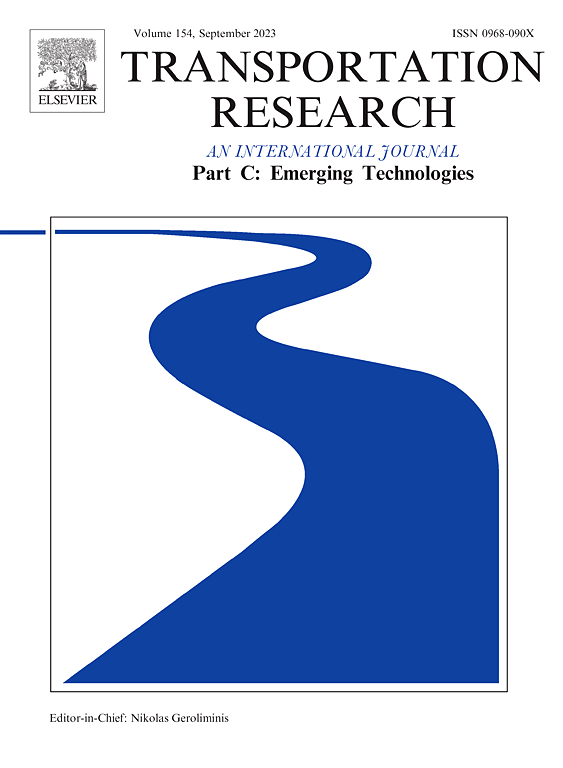Mobility resilience and recovery dynamics: Parsimonious framework beyond V-shapes
IF 7.6
1区 工程技术
Q1 TRANSPORTATION SCIENCE & TECHNOLOGY
Transportation Research Part C-Emerging Technologies
Pub Date : 2025-04-26
DOI:10.1016/j.trc.2025.105122
引用次数: 0
Abstract
System resilience is increasingly crucial in responding to disruptions from human activities, climate change, earthquakes, pandemics, etc. Existing literature commonly employs V-shaped or variants, such as U-shaped or trapezoid-shaped models, to describe system performance trends, but capturing the non-linear dynamics, identifying steady-state points, and analyzing impacts by interventions have been challenging, especially across multiple resolutions. While the challenges of extending the model to capture multiple waves are acknowledged, this study focuses exclusively on single-wave scenarios. To gain a deeper understanding of system resilience, this paper proposes an Ordinary Differential Equation (ODE): the Double Quadratic Queue (DQQ) model, which is adapted from the fluid-based Polynomial Arrival Queue (PAQ) model proposed by Newell (1982). The DQQ Model offers a parsimonious framework for understanding and estimating the dynamic evolution of disruption and recovery processes. The queue-theoretical ODE is adapted to multiple resolutions from national to route level in complex systems and is capable of identifying steady-state points and quantifying system resilience metrics. To validate the applicability, this paper employs transit mobility data at national, state, and county resolutions from Google COVID-19 Community Mobility Reports and two-way ridership data for RapidRide routes in King County, Seattle. The results reveal that the DQQ model demonstrates a notable improvement over the traditional models, particularly in identifying and approximating stabilization status at the end of the recovery process. Also, this paper conducts regression analysis to examine the correlation between resilience metrics. In addition, to examine the impact of the interventions on the system’s recovery capability, statistical analysis is conducted to analyze the impact of the new opening of the H Line to other lines.
流动性、弹性和恢复动力学:超越v型的简约框架
系统恢复能力在应对人类活动、气候变化、地震、流行病等造成的破坏方面日益重要。现有文献通常使用v形或变体,如u形或梯形模型来描述系统性能趋势,但捕获非线性动力学,识别稳态点,并分析干预的影响一直具有挑战性,特别是在多个分辨率下。虽然承认扩展模型以捕获多波的挑战,但本研究仅关注单波场景。为了更深入地理解系统弹性,本文提出了一种常微分方程(ODE):双二次队列(Double Quadratic Queue, DQQ)模型,该模型改编自Newell(1982)提出的基于流体的多项式到达队列(Polynomial Arrival Queue, PAQ)模型。DQQ模型为理解和估计中断和恢复过程的动态演变提供了一个简洁的框架。队列理论ODE适用于复杂系统中从国家到路由级别的多种解决方案,能够识别稳态点并量化系统弹性指标。为了验证其适用性,本文采用了谷歌COVID-19社区流动性报告中国家、州和县的交通流动性数据以及西雅图金县快速骑行路线的双向乘客数据。结果表明,与传统模型相比,DQQ模型具有显著的改进,特别是在恢复过程结束时稳定状态的识别和近似方面。并通过回归分析来检验弹性指标之间的相关性。此外,为了检验干预措施对系统恢复能力的影响,对H线新开通对其他线路的影响进行了统计分析。
本文章由计算机程序翻译,如有差异,请以英文原文为准。
求助全文
约1分钟内获得全文
求助全文
来源期刊
CiteScore
15.80
自引率
12.00%
发文量
332
审稿时长
64 days
期刊介绍:
Transportation Research: Part C (TR_C) is dedicated to showcasing high-quality, scholarly research that delves into the development, applications, and implications of transportation systems and emerging technologies. Our focus lies not solely on individual technologies, but rather on their broader implications for the planning, design, operation, control, maintenance, and rehabilitation of transportation systems, services, and components. In essence, the intellectual core of the journal revolves around the transportation aspect rather than the technology itself. We actively encourage the integration of quantitative methods from diverse fields such as operations research, control systems, complex networks, computer science, and artificial intelligence. Join us in exploring the intersection of transportation systems and emerging technologies to drive innovation and progress in the field.

 求助内容:
求助内容: 应助结果提醒方式:
应助结果提醒方式:


